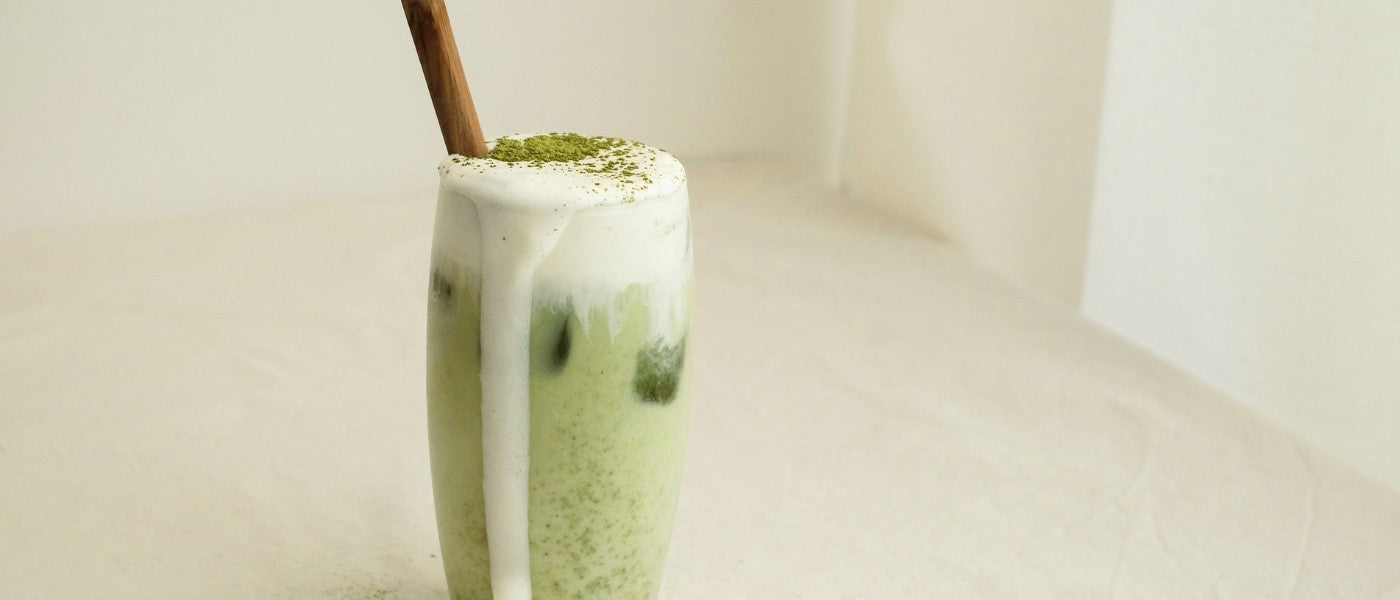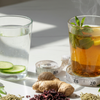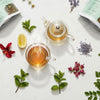Matcha Tea 101: The Complete Guide to Japan's Green Gold

In a world where coffee dominates the morning routine and energy drinks fuel afternoon slumps, there exists an ancient Japanese treasure that offers something far more profound—sustained energy, mental clarity, and a moment of zen all wrapped into one vibrant green powder. Welcome to the extraordinary world of matcha tea.
This isn't just another health trend or coffee alternative. Matcha represents centuries of Japanese tradition, meticulous craftsmanship, and a philosophy that views tea preparation as a meditative art form. Whether you're seeking natural energy, exploring mindful living, or simply curious about this emerald-colored phenomenon, this complete guide will transform you from a matcha novice into a knowledgeable enthusiast.
What Is Matcha Tea? Understanding Japan's Green Treasure
Matcha is far more than regular green tea. While traditional green tea involves steeping leaves in hot water and discarding them, matcha is the entire tea leaf ground into an ultra-fine powder that you consume completely. This fundamental difference means you're ingesting the whole leaf, maximizing both flavor intensity and nutritional benefits.
The word "matcha" literally means "powdered tea" in Japanese:
- Ma (抹) = powder
- Cha (茶) = tea
But this simple translation doesn't capture the complexity behind this remarkable beverage. True matcha is the result of a sophisticated cultivation process that has been refined over more than 800 years, combining agricultural expertise, artisanal skill, and spiritual philosophy.
The Origins: From Chinese Monasteries to Japanese Tea Ceremonies
Matcha's story begins in ancient China during the Tang Dynasty (618-907 AD), where Buddhist monks discovered that grinding tea leaves into powder created a more potent and convenient form of tea. However, it was in Japan where matcha truly flourished and evolved into the cultural icon we know today.
In 1191, the Zen monk Eisai brought tea seeds and the knowledge of powdered tea from China to Japan. The Japanese embraced and refined this practice, eventually developing the elaborate tea ceremony known as "chanoyu" or "sado." This ceremony transformed simple tea drinking into a spiritual practice emphasizing mindfulness, respect, and harmony.
The Unique Cultivation Process: Why Matcha Is So Special
Understanding how matcha is grown and processed helps explain why authentic matcha commands premium prices and offers exceptional benefits:
Shade Growing: The Secret to Matcha's Magic
The Shading Process:
- Tea plants destined for matcha are covered with shade cloths 3-4 weeks before harvest
- This reduces sunlight exposure by 90%, fundamentally altering the plant's chemistry
- Chlorophyll production increases dramatically, creating matcha's signature vibrant green color
- Amino acid content, particularly L-theanine, increases significantly
- Tannin production decreases, resulting in less bitterness
Harvesting: Timing Is Everything
The Perfect Harvest:
- Only the youngest, most tender leaves are selected
- Harvesting typically occurs in late April to early May
- Leaves are hand-picked in the early morning when amino acid content is highest
- Only the top two leaves and bud of each stem are used
- Weather conditions must be perfect—no rain or strong winds
Processing: From Leaf to Powder
The Traditional Method:
- Steaming: Fresh leaves are immediately steamed to halt oxidation
- Drying: Leaves are air-dried to become "tencha"
- De-stemming: Stems and veins are meticulously removed
- Stone grinding: Tencha is ground in traditional stone mills for hours
The stone grinding process is crucial—authentic matcha is ground between two granite stones that rotate slowly to avoid generating heat that would damage the delicate compounds. It takes one hour to produce just 30-40 grams of matcha powder.
Understanding Matcha Grades: From Everyday to Ceremonial
Not all matcha is created equal. Understanding the different grades helps you choose the right matcha for your needs and budget:
Ceremonial Grade: The Crown Jewel
Characteristics:
- Made from the youngest, most tender leaves
- Vibrant jade green color
- Sweet, smooth taste with minimal bitterness
- Creamy, velvety texture when whisked
- Traditionally consumed plain without additives
Best for: Traditional tea ceremony, drinking plain, special occasions
Premium Grade: The Daily Luxury
Characteristics:
- High quality with excellent flavor balance
- Bright green color
- Good for both drinking plain and in recipes
- Smooth texture with slight grassiness
- More accessible pricing than ceremonial grade
Best for: Daily matcha drinking, occasional ceremonies, quality matcha lattes
Culinary Grade: The Kitchen Workhorse
Characteristics:
- Stronger, more robust flavor that holds up in recipes
- Good color retention when mixed with other ingredients
- More bitter when consumed plain
- Cost-effective for cooking and baking
- Often more readily available
Best for: Baking, cooking, smoothies, ice cream, budget-friendly lattes
How to Identify Quality Matcha
Visual Indicators:
- Color: Vibrant jade green (avoid yellowish or brownish powders)
- Texture: Ultra-fine powder that feels like silk
- Packaging: Sealed in light-proof containers with recent harvest dates
- Origin: Authentic Japanese matcha from recognized regions
Taste Indicators:
- Umami: Rich, savory depth
- Sweetness: Natural sweetness without sugar
- Minimal bitterness: High-quality matcha should not be overwhelmingly bitter
- Smooth finish: No harsh or chalky aftertaste
The Science of Matcha: Why It's a Nutritional Powerhouse
Matcha's unique cultivation and processing methods create a nutritional profile that sets it apart from all other teas:
Antioxidant Superstar
EGCG (Epigallocatechin Gallate):
- Matcha contains 137 times more antioxidants than regular green tea
- One serving provides the antioxidant equivalent of 10 cups of regular tea
- Supports cellular health and may help combat aging
- Provides protection against environmental stressors
L-Theanine: The Calm Focus Compound
The Zen Factor:
- Matcha contains 5 times more L-theanine than regular green tea
- Promotes alpha brain waves associated with calm alertness
- Works synergistically with caffeine to provide sustained energy without jitters
- Supports stress reduction and improved focus
Caffeine: Clean Energy
Sustained Energy Without the Crash:
- Contains about 70mg of caffeine per serving (vs. 95mg in coffee)
- Caffeine is released slowly due to L-theanine binding
- Provides 3-6 hours of sustained energy
- Avoids the typical caffeine crash associated with coffee
Chlorophyll: Natural Detoxification
The Green Advantage:
- High chlorophyll content supports natural detoxification
- May help eliminate heavy metals and chemicals from the body
- Supports healthy digestion and alkaline balance
- Provides the vibrant green color that indicates quality
Additional Nutrients
Vitamin and Mineral Content:
- Vitamin C: Supports immune system and collagen production
- Vitamin A: Supports eye health and immune function
- Iron: Important for oxygen transport and energy
- Potassium: Supports heart health and muscle function
- Calcium: Bone health and muscle function
Health Benefits: The Science-Backed Advantages
Research continues to validate many of matcha's traditional health claims:
Cognitive Enhancement
Mental Performance:
- Improves attention and reaction time
- Enhances working memory and cognitive flexibility
- Supports sustained focus without mental fatigue
- May help protect against age-related cognitive decline
Metabolic Support
Weight Management:
- May increase fat oxidation during exercise
- Supports healthy metabolism through thermogenesis
- Helps regulate blood sugar levels
- May reduce abdominal fat accumulation
Heart Health
Cardiovascular Benefits:
- May help lower LDL (bad) cholesterol
- Supports healthy blood pressure levels
- Improves arterial health and circulation
- Reduces inflammation markers
Immune System Support
Defense Enhancement:
- High antioxidant content supports immune function
- May help reduce inflammation throughout the body
- Supports the body's natural detoxification processes
- Provides antimicrobial properties
Stress Reduction
Calm Energy:
- L-theanine promotes relaxation without drowsiness
- May help reduce cortisol levels
- Supports better sleep quality when consumed earlier in the day
- Promotes a meditative state of mind
The Art of Preparing Matcha: Traditional and Modern Methods
Traditional Preparation: The Japanese Way
Essential Tools:
- Chawan: Wide, shallow tea bowl
- Chasen: Bamboo whisk with 80-120 prongs
- Chashaku: Bamboo tea scoop
- Furui: Fine mesh sifter
Step-by-Step Traditional Method:
- Warm the bowl: Pour hot water into the chawan, swirl, and discard
- Sift the matcha: Use a fine sifter to remove any clumps
- Measure: Use the chashaku to add 1-2 scoops (about 1 teaspoon) of matcha
- Add water: Pour 60ml (about 2oz) of 175°F water into the bowl
- Whisk: Using the chasen, whisk in a "W" motion rapidly for 15-20 seconds
- Check consistency: The matcha should be frothy with fine bubbles
- Enjoy mindfully: Drink immediately while contemplating the moment
Temperature Tips:
- Water should be 175°F (80°C) - not boiling
- Too hot water will make matcha bitter
- Too cool water won't dissolve the powder properly
Modern Preparation Methods
The Simple Bowl Method:
- Use any wide bowl and small whisk
- Follow the same ratio: 1 tsp matcha to 2oz water
- Whisk vigorously until frothy
- Perfect for daily consumption
The Shaker Method:
- Add matcha and small amount of room temperature water to jar
- Shake vigorously to create a paste
- Add remaining warm water and shake again
- Great for on-the-go preparation
The Blender Method:
- Combine matcha with liquid in high-speed blender
- Blend for 30-60 seconds until completely smooth
- Excellent for matcha lattes and smoothies
Creative Ways to Enjoy Matcha
While traditional preparation is beautiful, modern matcha enthusiasts have created countless delicious variations:
Matcha Beverages
Classic Matcha Latte:
- 1 tsp matcha powder
- 2 tbsp hot water
- 6oz steamed milk of choice
- Optional: honey or maple syrup to taste
Iced Matcha Latte:
- 1 tsp matcha powder
- 2 tbsp hot water to dissolve
- Ice cubes
- Cold milk of choice
- Natural sweetener if desired
Matcha Smoothie:
- 1 tsp matcha powder
- 1 banana
- 1 cup coconut milk
- 1 tbsp almond butter
- Ice cubes
- Blend until smooth
Matcha Culinary Creations
Matcha White Chocolate:
- High-quality white chocolate melted with matcha powder
- Creates beautiful green confections
- Perfect balance of sweet and earthy flavors
Matcha Ice Cream:
- Homemade or store-bought vanilla ice cream base
- Gradually fold in sifted matcha powder
- Adjust sweetness as needed
Matcha Tiramisu:
- Replace coffee with matcha in traditional tiramisu
- Use matcha-soaked ladyfingers
- Dust with additional matcha powder
Matcha Salt:
- Mix matcha powder with high-quality sea salt
- Excellent finishing salt for seafood and vegetables
- Unique umami flavor enhancement
Choosing and Storing Matcha: Maximizing Quality and Freshness
Selecting Quality Matcha
What to Look For:
- Japanese origin: Authentic matcha comes from Japan
- Harvest date: Fresher is always better
- Color: Vibrant jade green, not yellowish
- Packaging: Light-proof, airtight containers
- Price: Quality matcha is an investment—be wary of very cheap options
Reputable Regions:
- Uji, Kyoto: The most famous and traditional matcha region
- Nishio, Aichi: Known for high-quality, consistent matcha
- Shizuoka: Produces both ceremonial and culinary grades
Proper Storage Techniques
Unopened Matcha:
- Store in refrigerator or freezer
- Keep in original packaging until ready to use
- Can last 1-2 years when properly stored
Opened Matcha:
- Use within 1-2 months for best quality
- Store in airtight container in refrigerator
- Let come to room temperature before opening to prevent condensation
- Never store in direct light or heat
Signs of Deterioration:
- Color change from green to yellow/brown
- Loss of vibrant flavor
- Increased bitterness
- Clumping or changes in texture
Matcha Etiquette and Cultural Appreciation
Understanding Tea Ceremony Principles
The Four Principles of Tea Ceremony:
- Wa (和): Harmony with others and nature
- Kei (敬): Respect for all people and things
- Sei (清): Purity of heart and mind
- Jaku (寂): Tranquility and peace
Modern Mindful Consumption
Bringing Ceremony to Daily Life:
- Take time to prepare matcha mindfully
- Appreciate the color, aroma, and flavor
- Use the preparation time as a moment of meditation
- Share the experience with others when possible
Common Matcha Mistakes and How to Avoid Them
Preparation Mistakes
Using Boiling Water:
- Problem: Creates bitter, harsh flavor
- Solution: Use 175°F (80°C) water
Insufficient Whisking:
- Problem: Clumpy, poorly dissolved matcha
- Solution: Whisk vigorously for at least 15-20 seconds
Wrong Ratios:
- Problem: Too weak or overpoweringly strong
- Solution: Start with 1 tsp matcha to 2oz water and adjust to taste
Storage Mistakes
Room Temperature Storage:
- Problem: Rapid deterioration of color and flavor
- Solution: Always refrigerate after opening
Light Exposure:
- Problem: Breaks down beneficial compounds
- Solution: Store in dark, opaque containers
The Future of Matcha: Trends and Innovations
Growing Global Popularity
Market Expansion:
- Matcha cafes opening worldwide
- Integration into mainstream food and beverage products
- Increased awareness of health benefits
- Rising demand for authentic, quality products
Innovative Applications
Modern Culinary Uses:
- Matcha in fine dining restaurants
- Artisanal matcha chocolates and desserts
- Matcha-infused spirits and cocktails
- Functional food applications
Health and Wellness Integration:
- Matcha supplements and powders
- Athletic performance applications
- Stress management programs
- Mindfulness and meditation practices
Embracing the Matcha Lifestyle
Matcha offers far more than just another beverage option—it provides an invitation to slow down, be present, and nourish both body and mind. Whether you're drawn to its impressive health benefits, intrigued by its cultural significance, or simply love its unique flavor, matcha has something to offer every wellness journey.
The ritual of preparing matcha creates a moment of mindfulness in our busy lives, while its nutritional profile supports sustained energy, mental clarity, and overall well-being. As you explore the world of matcha, remember that quality matters, preparation is an art form, and every cup is an opportunity to practice gratitude and presence.
From the ancient tea masters of Japan to modern wellness enthusiasts around the world, matcha continues to inspire and nourish. Your journey with matcha is just beginning—embrace the vibrant green path to wellness, one mindful sip at a time.
Ready to discover the transformative power of authentic matcha? Begin your journey with high-quality, ceremonial-grade matcha and experience the difference that centuries of tradition and cultivation expertise can make in your daily wellness routine.




